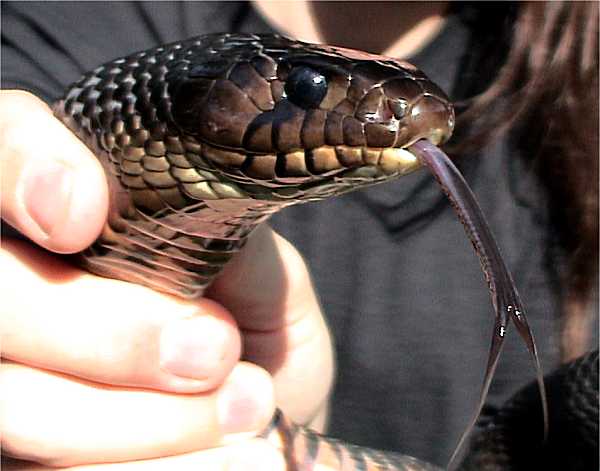Drymarchon Melanurus Rubidus on:
[Wikipedia]
[Google]
[Amazon]
''Drymarchon'' is a genus of large nonvenomous colubrid snakes, commonly known as indigo snakes or cribos, found in the Southeastern United States, Central America, and South America. Reaching or more in length, they are among the world's largest colubrid snakes.
 The genus ''Drymarchon'' was formerly considered to be a monotypic taxon formed by
The genus ''Drymarchon'' was formerly considered to be a monotypic taxon formed by
The Indigo Snake Systematics Page: A New Species of Indigo Snake (''Drymarchon'') from Venezuela, and a Reclassification of the Genus
"Black Snakes": Identification and Ecology
- University of Florida fact sheet. {{Taxonbar, from=Q2363493 Colubrids Reptiles of the United States Reptiles of Central America Reptiles of South America Snake genera Taxa named by Leopold Fitzinger
Description
Indigo snakes are large, robust snakes which can reach a total length (including tail) of over . They have smooth dorsal scales, and several color variations, including a glossy blue-black color. This snake genus, Drymarchon, means "Lord of The Forest". This is a sexually dimorphic species so the males are larger than the females. This is thought to be due to intraspecies competition from the males.Behavior and diet
Indigo snakes are diurnal and actively forage for prey. They feed on a broad variety of small animals such asrodents
Rodents (from Latin , 'to gnaw') are mammals of the order Rodentia (), which are characterized by a single pair of continuously growing incisors in each of the upper and lower jaws. About 40% of all mammal species are rodents. They are nat ...
, birds
Birds are a group of warm-blooded vertebrates constituting the class Aves (), characterised by feathers, toothless beaked jaws, the laying of hard-shelled eggs, a high metabolic rate, a four-chambered heart, and a strong yet lightweigh ...
, lizards
Lizards are a widespread group of squamate reptiles, with over 7,000 species, ranging across all continents except Antarctica, as well as most oceanic island chains. The group is paraphyletic since it excludes the snakes and Amphisbaenia althou ...
, frogs, toads, and other snakes
Snakes are elongated, limbless, carnivorous reptiles of the suborder Serpentes . Like all other squamates, snakes are ectothermic, amniote vertebrates covered in overlapping scales. Many species of snakes have skulls with several more joi ...
, including rattlesnakes.
They are not aggressive snakes and will bite only when threatened. Typical threat display includes hissing and shaking of its tail as a warning.
Habitat
The current distribution of D. Couperi is reported as extending from the Coastal Plain of southern Georgia to peninsular Florida and the lower Florida Keys west to Southeastern Mississippi. They use a variety of different habitats, including longleaf pine-turkey oak sandhills, pine and scrub flatwoods, dry prairie, tropical hardwoods, freshwater wetlands, and coastal dunes; however, winter survival, especially in northern portions of its range, depends on the availability of appropriate shelters which are primarily Gopher Tortoise burrows. These burrows can be used to hide from predators, fires, and extreme temperatures.Threats
Populations in Alabama, Texas, and South Carolina have been largely lost due to habitat destruction, poaching, and killings. Indigo snakes are currently protected under the United States Fish and Wildlife Service and the Florida Fish and Wildlife Conservation Commission which makes it illegal to possess, harm, or harass them. Permits are also required in order to keep or transport this species.Species and subspecies
 The genus ''Drymarchon'' was formerly considered to be a monotypic taxon formed by
The genus ''Drymarchon'' was formerly considered to be a monotypic taxon formed by subspecies
In biological classification, subspecies is a rank below species, used for populations that live in different areas and vary in size, shape, or other physical characteristics (morphology), but that can successfully interbreed. Not all species ...
of ''D. corais''. Currently the genus includes six distinct species recognized by ITIS: One of the species has several subspecies which are recognized as being valid.
* Indigo snake, yellow-tailed indigo snake — ''Drymarchon corais
The indigo snake (''Drymarchon corais'') is a species of snake of the family Colubridae. This large colubrid snake is nonvenomous.
Taxonomy
Until recently, all ''Drymarchon'' were classified as subspecies of ''D. corais''. However, North and Centr ...
''
*Falcon indigo snake
Falcons () are birds of prey in the genus ''Falco'', which includes about 40 species. Falcons are widely distributed on all continents of the world except Antarctica, though closely related raptors did occur there in the Eocene.
Adult falcons ...
— ''Drymarchon caudomaculatus''
* Eastern indigo snake — ''Drymarchon couperi''
* Margarita indigo snake — ''Drymarchon margaritae''
* Middle American indigo snake — ''Drymarchon melanurus''
**Black-tailed cribo — ''Drymarchon melanurus melanurus''
**Texas indigo snake
''Drymarchon melanurus erebennus'', commonly known as the Texas indigo snake, is a subspecies of large, nonvenomous snake in the family Colubridae. The subspecies is native to Texas and adjacent Mexico.
Geographic range
''D. m. erebennus'' ...
— ''Drymarchon melanurus erebennus''
**Orizaba indigo snake — ''Drymarchon melanurus orizabensis''
**Mexican red-tailed indigo snake — ''Drymarchon melanurus rubidus''
**Unicolor cribo — ''Drymarchon melanurus unicolor''
'' Nota bene'': A binomial authority
In taxonomy, binomial nomenclature ("two-term naming system"), also called nomenclature ("two-name naming system") or binary nomenclature, is a formal system of naming species of living things by giving each a name composed of two parts, bot ...
or a trinomial authority in parentheses indicates that the species or subspecies was originally described in a genus other than ''Drymarchon''.
References
External links
The Indigo Snake Systematics Page: A New Species of Indigo Snake (''Drymarchon'') from Venezuela, and a Reclassification of the Genus
"Black Snakes": Identification and Ecology
- University of Florida fact sheet. {{Taxonbar, from=Q2363493 Colubrids Reptiles of the United States Reptiles of Central America Reptiles of South America Snake genera Taxa named by Leopold Fitzinger